About Leroy Grumman & the navy
The Founder: Leroy Grumman
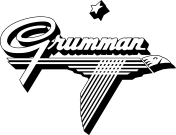
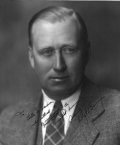 Leroy Grumman was born in Huntington, New York. His father George Tyson Grumman, owned a carriage shop and later worked at the post office.
Leroy Grumman was born in Huntington, New York. His father George Tyson Grumman, owned a carriage shop and later worked at the post office.Early years and WWI
"Red Mike" as a youngster was already fascinated with aviation, predicting in his Huntington High school 1911 salutatory address, the future of the aeroplane. With a Bachelor of Science degree in mechanical engineering from Cornell University (1916) he first worked at the engineering department, New York Telephone Co. He enlisted in June 1917 at the U.S. Naval Reserve (machinist's mate, 2nd class) specializing in "subchaser" engines.
At Loening Aircraft (1920)
He started work at Loening Aircraft Engineering Corporation in 1920. The company was then acquired by Keystone Aircraft Corp. Grumman however did not fared well with the new direction and decided to leave (not alone as it appeared).
Grumman Co. Parts, Long Island (1929)He moved to Bristol in Pennsylvania by 1929, creating with hown company with former colleagues from Loening, also rebuffed by the new direction. The workshop settled with the dilapidated Cox-Klemin factory in Baldwin, Long Island, New York. The paperwork was ready and the company in existence by December 6, 1929. It opened to business by January 2, 1930. At first, it specialized in welding aluminium tubing for truck frames. However Leroy Grumman still wanted to target the Navy for aircraft contracts, and when specifications were emitted, proposed new floats types with an integrated retractable landing gear. This was the first step leading to the birth of his first model, the FF-1 biplane.
First Patents: The early days of Grumman
On 2 January 1930, the company settled in an abandoned auto showroom garage in Baldwin, New York with a tarmac already used by the Cox-Klemin Aircraft Co. factory. With a crew of 18 it started repairing damaged Loening amphibians with a surplus parts stock purchased from Loening works. This expertise in aluminum led him to create both floats and truck bodies. Grumman and Swirbul (the latter as vice-president) soon learned the U.S. Navy wanted a retractable landing gear for carrier operations. Leroy Grumman took and earlier design for the Loening Air Yacht, adapted it and deposed it under U.S. Patent 1,859,624 in 1932. It was using gravity and was manually operated, just sturdy and reliable enough for hard deck landings. The U.S. Navy tested it and appreciated enough to ask for fitting it to current models such as O2U. This was the true start.A long Lineage
Grumman and his "Cats" made history: FF, F2F, F3F, F4F, F6F, F7F and F8F all indispensible USN fighters, or the massive TBF Avenger, which helped turn the tide in the Pacific. The company's reputation now well sold to the US Admiralty, it went on with the same success in the cold war with the Panther and Tomcat, the Intruder and Hawkeye, Prowler, until merging with Northrop with the great reorganizations of the 1980s. The company is no longer in the "first row" and was granted recently only a contract to overhaul and modernize the E-6B Mercury. The first line fighter of the USN is now from McDonnell Douglas, the Hornet and Hornet II, and the famous F-35 is from Lockheed Martin.
Towards the Grumman FF: Starting a legacy
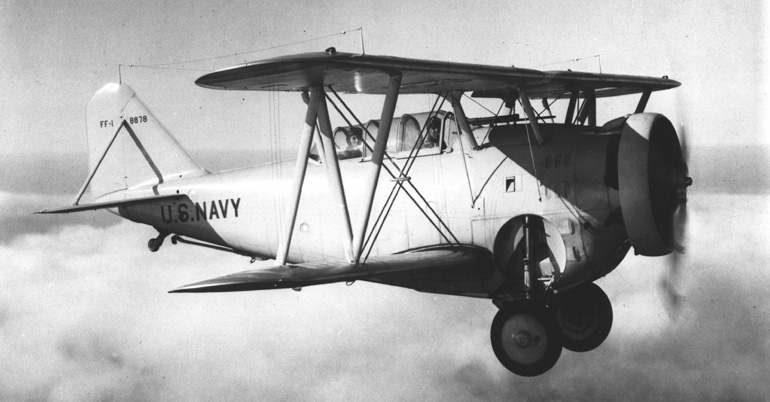
The popular "Fifi", first success of the company and fastest fighter of the US Navy in 1933
Before the creation of the FF-1, Grumman’s first complete aircraft design, the Navy indeed had asked Grumman to fit his company's ingenious retractable landing gear on the Vought O2U-1 Corsair Scout, while the O2U-4, was fitted with a new Grumman float. Grumman's "splayed out" landing gear was just one of his abilities as an engineer and designer to foresee technical problems and their solutions. Later he would cteate his second trademark, the "Sto-Wing" wing-panel folding system, installed on the F4 Wildcat. Although the Navy was his prime contractor he also seen the commercial market as profitable niche for amphibians, developing the G-21 "Goose" and G-22 "Gulfhawk" derived from the Grumman F3F.
But it's really the interest shown by the Navy for its landing gear that conducted some to expect improved performances, quite important for a fighter, by removing the fixed undercarriage causing a lot of drag in all flight configurations. Therefore he was soon asked to retrofit the same landing gear on the Boeing F4B-1 fighter currently in service. Instead Grumman famously rose to the occasion and proposed its own fighter design. Soon after XFF-1 was built on a 22 April 1931 contract, making its maiden flight in December that year.
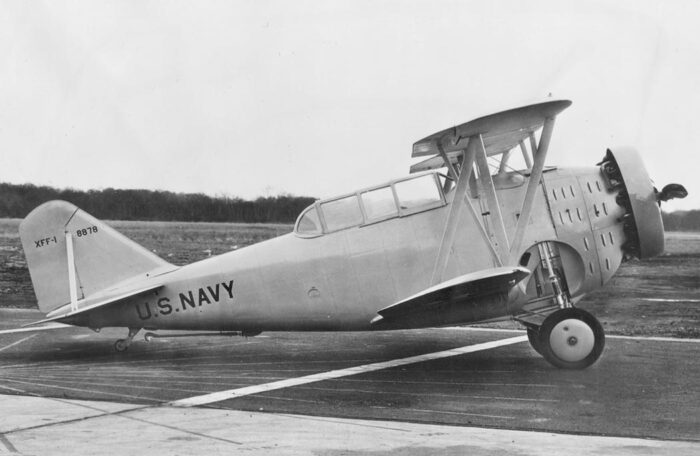
Grumman XFF-1 in December 1931
It was a kind of hybrid, with two-seat and enclosed cockpit, and all-metal fuselage while wings were covered with fabric. The initial 616 hp Wright R-1820-E Cyclone was replaced in production by the more powerful 750 hp (560 kW) Wright R-1820-F Cyclone allowing the record speed of 201 mph (323 km/h) in the Navy.
Production was limited to single-seat 27 FF-1 in December 1932 plus 33 scouts (SF-1s) with two-seats and R-1820-84 Cyclone engine. Other versions of the Grumman F3F followed and a total of 116 as ultimately built. This was just a pinprick compared to the production of the following wartime F4F, the first to have a proper name, the first of the "cats".His famous rectractable landing gear also made its way via Grover-Loening on the other fighter of this generation, the Curtiss BF2C Goshawk.
Detailed Design
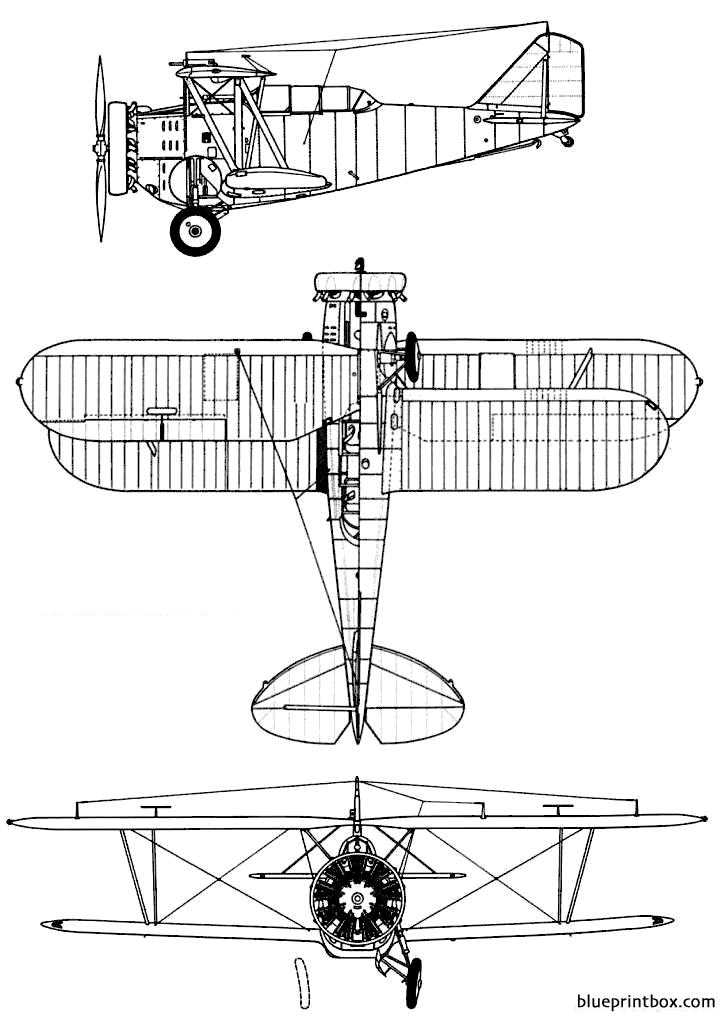
Grumman FF-1, 3 views
Structure, fuselage and wings
The Grumman FF was a single-bay, equal span biplane of composite construction. The main fuselage was mostly made of framing tubes wrapped into aluminium paneling, but the rear sectionThe tail, elevons, and the wings were made ot metal framework wrapped in fabric. The central section housed seatings for its crew of two, pilot and observer which sat in tandem in a covered (glass house) cockpit. This was a first. Both had retractable frames, the rear one to free the flexible mounted machine gun.
Grumman XSF-2
The biplane used parallel struts, reinforced by usual steel cabling between the upper and lower assemblies. The upper assembly was a couple of fieets above the forward cowling, for better pilot's view, and connected by two "N" struts and crossed cabling. The lower wing assembly rested on the belly. The tail unit (vertical tail fin) and low-set horizontal planes had conventional straight and rounded shapes. Other equipments included the arrestor hook underbelly aft, under the tail unit and small tail wheel, not retractable into the rear section (it remained fixed in flight) the drag was compensated by the weight saved by the absence of a retracting mechanism. All its novel features, retractable undercarriage, fully enclosed cockpit, modern instrument panel, metal skinning along the fuselage rather than canvas, made it looking very modern despite its biplane configuration, and study as well, something that would be soon associated with in-house products.
The most interesting feature, clearly an innovation proper to Leroy Grumman, was its retractable main landing gear design sittin within the belly structure forward of the main wings. It was was pioneered already at Grover Loening with Jake Swirbul in 1928. Both were now at the head of Grumman after Loening Aeronautical Engineering Co. closed its doors. The XFF-1 was absorbed in effect into Grumman. Grumman formerly contributed to the manual crank-operated retractable main gear proper to Loening designs also adopted by the F2F and F3F, later F4F Wildcat, Grumman JF and J2F Duck.
This system was merely an answer to existing systems of the time which were more complex and electric. None could stand the carrier deck's had landings. The undercarriage used gravity to deploy automatically, "helped" by a hand-crank with demultiplying gears activated by the pilot. The only limitation of the system was that is focused the attention of the pilot inside the cosckpit rather than monitoring his environment. The next step was generally the difficult landing.

FF-1 cockpit interior - ONI
Powerplant and Performances
Power was provided by the large, trusted Wright R-1820-E "Cyclone" radial piston engine. Thnaks to this, the FF showcased a top speed of 207 mph or 333 km/h at 4,000 ft (1200 m) which was quite acceptable, perhaps less for a fighter than for a versatile scout. Range was a bit short but coherent with models of that generation at 685 mi (1,100 km, 595 nmi). Service ceiling was relatively good the time at 22,100 ft (6,735 m) and it climbed ay 1,667 ft/min (8.47 m/s), also good, especially for a scout.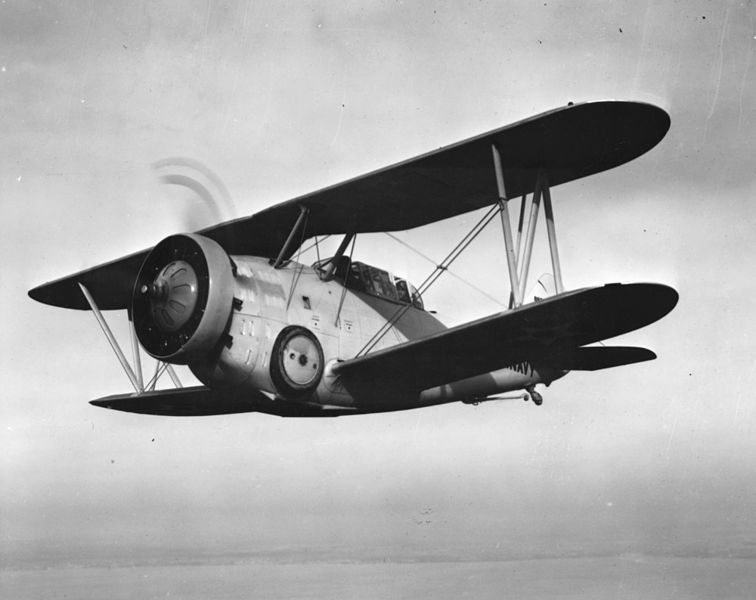
XFF-1 on trials, NAS Hampton Roads 4 Feb. 1932
Armament
Standard armament comprised two 0.30 caliber Browning M1919 machine guns, or in alternative later a single 0.30 in and 1x 0.5 in (12.7mm) Browning M2 in the fuselageThe rear observer/gunner was given a flexible mount with another Browning M1919
The FF had a light bombing capability: It could carry up to two 100 lb (45 kg) M30 or two 116 lb (53 kg) Mk4 bombs under wings.
Production
FF-1 Fighter: Production order consisted of 27 two-seat FF-1 (G-5).XSF-1a: second prototype A8940, two-seat scout called (Grumman G-6 internally) first flew on 19 December 1932.
Second order of 33 SF-1s, all out revised internal equipment and the Wright R-1820-84 Cyclone instead of the fighter engine.
Single prototype XSF-2 tested as a backup with a Pratt & Whitney R-1830 Twin Wasp engine.
F2F: As the Navy chages its specifications and moved to a more mature fighter, the Company soon developed the F2F. But the FF legacy continued:
Grumman G.23: Export version, 52 to Canada under licence (exluded from the total), and 34 for Spain (not counted either in the total), so 27 + 25 + 33 + 4 protos: 89. With the Canadian/Spanish ones, 141. The sole model tested in Japan did not made a strong impression apparently as none of its most obvious features were resued on domestic models.
Variants
XFF-1 Prototype serial A8878FF-1 (27 built): 2-seat fighter
FF-2 (25 built): Converted fighter at NAF with dual controls as trainer
XSF-1: Second prototype serial A8940, better engine and other features
SF-1 (33 built): 2-seat carrier-borne scout
XSF-2: SF-1 airframe prototype with the 650 hp (485 kW) Pratt & Whitney R-1535-72 Twin Wasp Junior, Hamilton propeller
Goblin (52 built): export G-23s under licence by Canadian Car & Foundry.
AXG1: G-23 prototype to the Imperial Japanese Navy Air Service, evaluated by 1935.
GE.23 Delfin (34 built): Export variant for Spain
Users
Royal Canadian Air Force: No. 118 and 123 (Fighter) Squadrons 15+12 Goblin Mk.IImperial Japanese Navy: Single AXG for evaluation
Mexican Air Force: Single one, pattern for production (never followed)
Nigaraguaian Military Aviation Corps: Single GN-3 for evaluation
Spanish Republican Air Force: 34 (serials AD-001 to AD-034)
Spanish (Franco's) Ejército del Aire: 11 survivors
United States Navy: Two 1932 Fighter Groups, and 6 Scout Groups (see active career).
⚙ specifications | |
| Weight (Empty/Max TO) | 3,098 lb (1,405 kg)/4,677 lb (2,121 kg) |
| Length: | 24 ft 6 in (7.47 m) |
| Wingspan: | 34 ft 6 in (10.52 m) |
| Height: | 11 ft 1 in (3.38 m) |
| Wing area: | 310 sq ft (28.8 m2) |
| Engine | Wright R-1820-78 Cyclone radial engine, 700 hp (520 kW) |
| Propeller | Fixed pitch, 2 bladed metal, hamilton |
| Top Speed | 207 mph (333 km/h, 180 kn) at 4,000 ft (1200 m) |
| Rate of climb | 1,667 ft/min (8.47 m/s) |
| Ceiling | 22,100 ft (6,735 m) |
| Range | 685 mi (1,100 km, 595 nmi) |
| Armament | 2× 0.30 in or 0.3 or 0.5 fixed, 0.3 flex aft, 200 Ibs bombs |
| Crew | 2: Pilot and observer/gunner |
The "Fifi" in Action
US Navy Use:FF-1s arrived first to Fighter Squadron VF-5B based on USS Lexington from June 1933. SF-1s arrived from 30 March 1934 and were assigned to VS-3B also on USS Lexington.FF-1 and SF-1s started to be withdrawn by the end of 1936, sent to reserve units, but they still served there by late 1940. 22 surviving ones modified with dual controls by Naval Aicraft Factory (NAF) as FF-2s for instruction. Meanwhile Grumman deployed its efforts to promote its model on export. Even prior to the Canadian licencing, it was sent and demonstrated to Nicaragua, Japan, and Mexico. None purchased it but Nicaragua. The sold Japanese model mostly interested Japanese engineers for its undercarriage, but delays and detours to deliver it meant in between, better designs appeared, making it lost interest. It's fate is unknown.The single Mexican prototype was marked by Grumman wit Spanish intruction to be easily disassembled and reassembled for production instruction. It was to be a pattern aircraft, helping to setup a Mexican production line, but the project was soon cancelled.Canadian Use:
The Canadian Car and Foundry Co. obtained from Grumman the manufacturing licence for the G-23 (internal designation), which was a later FF-1 with many improvements. Canada managed to deliver 52 of the "Goblin Mark I", the first assembled from US-built components and the last with proper locally developed tooling. Although initially rejected as a fighter by the Royal Canadian Air Force as outdated and too slow, with the advent of war, the last 15 of the CC&F production batch were taken on strength as Goblin Is. The aircraft type served with the RCAF from 17 September 1940 until 21 April 1942. "A" Flight of No. 118 RCAF Sqn was equipped with Goblins at Rockcliffe in Ottawa, and subsequently became No. 118 (Fighter) Sqn., later stationed at Dartmouth, Nova Scotia, where the Goblins for a time constituted the sole fighter force on the east coast.
Spanish Use:
Later 34 from this order of 52 was acquired by the Spanish Republican government in 1937, bypassing US embargo by presenting fake Turkish credentials. This batch was referred to as the GE-23 Delfin ("Dolphin") entering service with the Spanish Republican Air Force. Pilots did the best they could but by 1938 already it was outclassed notably by the newly arrived Legion Condor Me-109. Losses were high but at least one had a "kill" (Heinkel He 59B biplane fighter) in duel. The 11 that survived entered Franco's Ejército del Aire Español. Pilots did not apreciated it and in WW2 the Fifi earned the local nickname "Pedro Rico" due to its shape.
Nicaragua:
The sole Nicaraguaian Grumman G-23 demonstrated was purchased and saw active service. It was only relegated to a scrap yard at Zololtan Air Field, in 1942, and rediscovered in 1961 by an amateur historian. Sold to a historical assocation it was purchased and shipped to the US to be restored. In 1966, the fully restored model (not flight-capable however) was ceded to the US Navy for the Naval Aviation Museum at Pensacola in Florida.
Gallery:
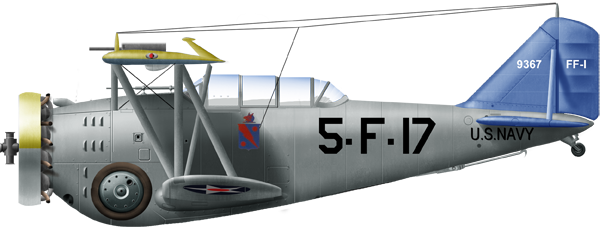
FF-1 VF-5b USS Lexington 1933

FF-2 NRAB Glenview Fighter Trainer
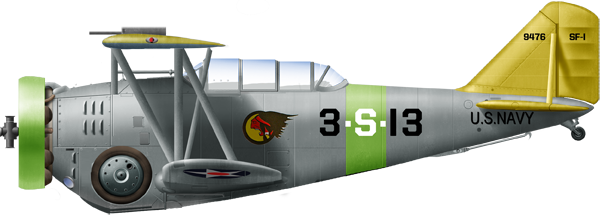
FF-2 SF-1 USS Lexington CO 5th section USS Lexington

Canadian Car & Foundry G-23 RCAN Goblin
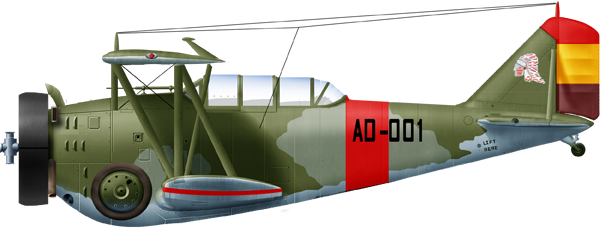
Canadian Car & Foundry Spanish G23 Delfin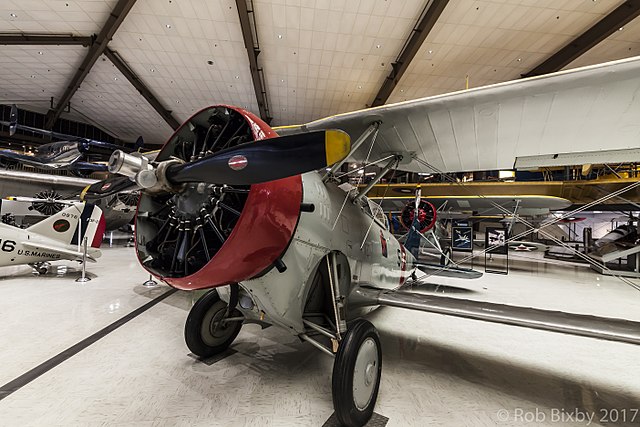
Closeup of the engine hood in the nat. naval air museum - Roy Bixby 2017 via Wikimedia commons
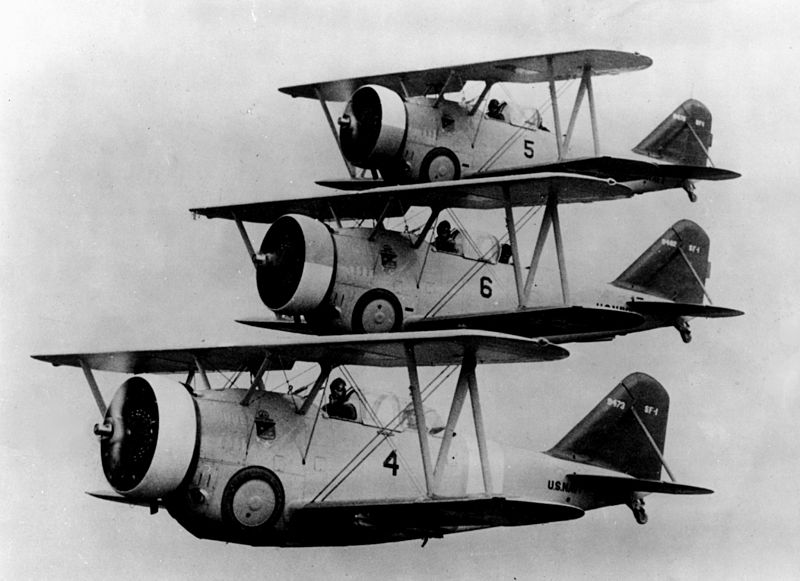
SF-1s in formation with the Naval Air Reserve in 1937
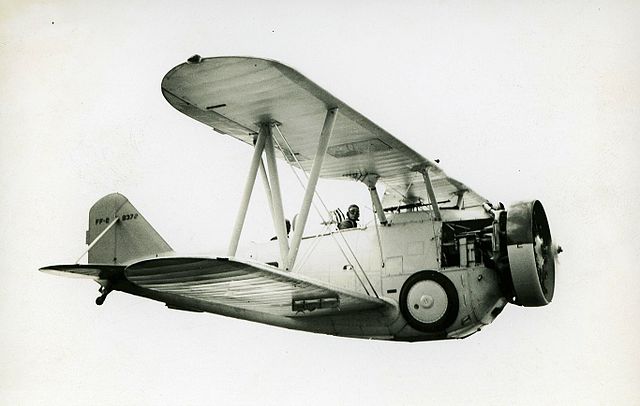
FF-2 in flight
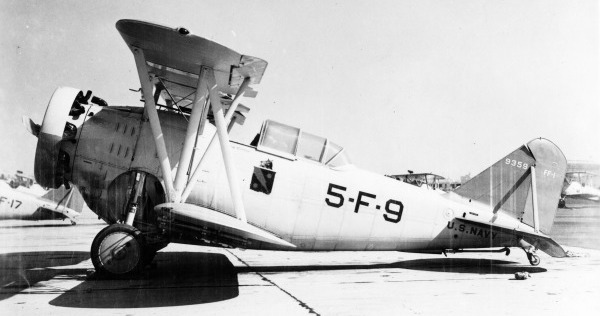
USN model - Ray Wagner coll.

Ex Canadian FF in Spain, 1939

British Goblin Mk.I at Darmouth 1941
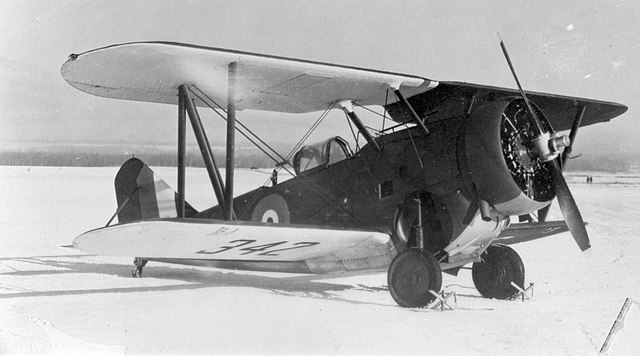
RCAN model in 1940
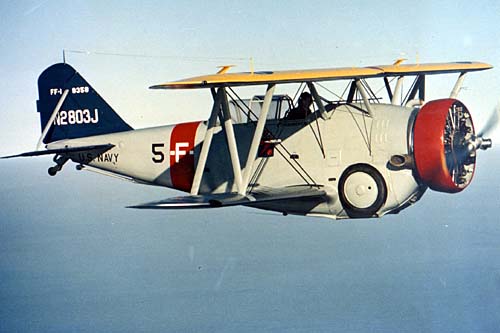
Ex-Nicaraguaian model restored to USN colors
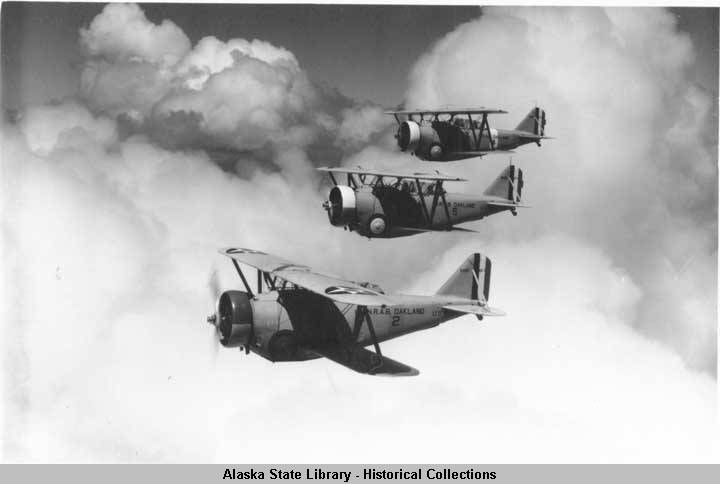
Three FF-1 in formation, from Alaska's digital archives under fair use.src
Swanborough and Bowers 1976, p. 195.
Merriam, Ray (2017). World War 2 in Review; No. 30; Grumman's Wildcat. Hoosick Falls, NY USA: Merriam Press.
FM 2 Wildcat landing gear test-2 (YouTube). Reno, NV USA: Robert Spellman.
"FM 2 Wildcat landing gear test you can see the mechanic in the cockpit hand cranking the gear up" Green and Swanborough 1988, p. 259.
"FF-1". National Naval Aviation Museum. Naval Aviation Museum Foundation.
Kostenuk, Samuel; Griffin, John (1977). RCAF Squadron Histories and Aircraft 1924-1968. Toronto: National Museum of Man Canada.
Wagner, R. (1982). American Combat Planes. Garden City, NY: Doubleday & Company, Inc.
Barrera, David Gesalí (2005). Delfín : el avion Grumman CC&F G-23 en la guerra civil española.
Cacutt, Len, ed. (1989). Great Aircraft of the World - "Grumman Single-Seat Biplane Fighters.". Marshall Cavendish.
Eden, Paul; Moeng, Soph (2002). The Complete Encyclopedia of World Aircraft.
Francillon, Rene J. (1989). Grumman Aircraft since 1929. Naval Institute Press.
Green, William (October 1966). "The Strange Story of Grumman's First Fighter". Flying Review International
Green, William; Swanborough, Gordon (1988). The Complete Book of Fighters. Barnes & Noble.
Green, William & Swanborough, Gordon (February–May 1979). "A Grumman by Any Other Name...". Air Enthusiast (9)
Levy, Howard (October 1966). "All the Way Home". Air Progress.
Levy, Howard (December 1966). "Canadian-built Goblin Restored". Canadian Aviation.
Listemann, Phil H. (2008). Grumman FF. Allied Wings No.6. London: Philedition.
Lumsden, Alec (April–July 1980). "Talkback". Air Enthusiast. No. 12.
Swanborough, Gordon; Bowers, Peter M. (1976). United States Navy Aircraft Since 1911. NIP
Winchester, Jim (2002). Fighters of the 20th Century. Shrewsbury, UK: Airlife Publishing.
On aeroweb.brooklyn.cuny.edu
books.google.fr/ the F4F story
On aviastar.org
On airvectors.net/
wikipedia- Leroy_Grumman
On Casemates Publishers
Photo on vilda.alaska.edu/
On aviation-central.com
On historyofwar.org
On airwar.ru
The Forgotten First Grumman | Grumman FF 'Fifi' [Aircraft Overview #60], Rex's hangar
https://youtu.be/A0OSLUaqIzg
F4F Landing gear retractation
Plenty of choice, from Paul Lindberg 1:19, to Hi-Flyer Grumman FF-1 20" Scientific 1:21 both very old, Megow 1:35, RVHP 1:48 (many), the 1937 kit Continental Model Airplane Co. 1:52, and scores of 1/72 models, the most recent being from MPM Production and Special Hobby.

FF-1 VF-5b USS Lexington 1933

FF-2 NRAB Glenview Fighter Trainer

FF-2 SF-1 USS Lexington CO 5th section USS Lexington

Canadian Car & Foundry G-23 RCAN Goblin

Canadian Car & Foundry Spanish G23 Delfin
Photos

Closeup of the engine hood in the nat. naval air museum - Roy Bixby 2017 via Wikimedia commons

SF-1s in formation with the Naval Air Reserve in 1937

FF-2 in flight

USN model - Ray Wagner coll.

Ex Canadian FF in Spain, 1939

British Goblin Mk.I at Darmouth 1941

RCAN model in 1940

Ex-Nicaraguaian model restored to USN colors

Three FF-1 in formation, from Alaska's digital archives under fair use.src
Src/Read more about the Grumman FF:
Books
Jordan, Corey C. "Grumman's Ascendency: Chapter One" Archived 2013-11-03 at the Wayback Machine Planes and Pilots Of World War Two, 2000.Swanborough and Bowers 1976, p. 195.
Merriam, Ray (2017). World War 2 in Review; No. 30; Grumman's Wildcat. Hoosick Falls, NY USA: Merriam Press.
FM 2 Wildcat landing gear test-2 (YouTube). Reno, NV USA: Robert Spellman.
"FM 2 Wildcat landing gear test you can see the mechanic in the cockpit hand cranking the gear up" Green and Swanborough 1988, p. 259.
"FF-1". National Naval Aviation Museum. Naval Aviation Museum Foundation.
Kostenuk, Samuel; Griffin, John (1977). RCAF Squadron Histories and Aircraft 1924-1968. Toronto: National Museum of Man Canada.
Wagner, R. (1982). American Combat Planes. Garden City, NY: Doubleday & Company, Inc.
Barrera, David Gesalí (2005). Delfín : el avion Grumman CC&F G-23 en la guerra civil española.
Cacutt, Len, ed. (1989). Great Aircraft of the World - "Grumman Single-Seat Biplane Fighters.". Marshall Cavendish.
Eden, Paul; Moeng, Soph (2002). The Complete Encyclopedia of World Aircraft.
Francillon, Rene J. (1989). Grumman Aircraft since 1929. Naval Institute Press.
Green, William (October 1966). "The Strange Story of Grumman's First Fighter". Flying Review International
Green, William; Swanborough, Gordon (1988). The Complete Book of Fighters. Barnes & Noble.
Green, William & Swanborough, Gordon (February–May 1979). "A Grumman by Any Other Name...". Air Enthusiast (9)
Levy, Howard (October 1966). "All the Way Home". Air Progress.
Levy, Howard (December 1966). "Canadian-built Goblin Restored". Canadian Aviation.
Listemann, Phil H. (2008). Grumman FF. Allied Wings No.6. London: Philedition.
Lumsden, Alec (April–July 1980). "Talkback". Air Enthusiast. No. 12.
Swanborough, Gordon; Bowers, Peter M. (1976). United States Navy Aircraft Since 1911. NIP
Winchester, Jim (2002). Fighters of the 20th Century. Shrewsbury, UK: Airlife Publishing.
Links
warfare.gq- the grumman sagaOn aeroweb.brooklyn.cuny.edu
books.google.fr/ the F4F story
On aviastar.org
On airvectors.net/
wikipedia- Leroy_Grumman
On Casemates Publishers
Photo on vilda.alaska.edu/
On aviation-central.com
On historyofwar.org
On airwar.ru
Videos
https://youtu.be/7JpsatWGeLEThe Forgotten First Grumman | Grumman FF 'Fifi' [Aircraft Overview #60], Rex's hangar
https://youtu.be/A0OSLUaqIzg
F4F Landing gear retractation
The Models Corner:
General Query on ScalematesPlenty of choice, from Paul Lindberg 1:19, to Hi-Flyer Grumman FF-1 20" Scientific 1:21 both very old, Megow 1:35, RVHP 1:48 (many), the 1937 kit Continental Model Airplane Co. 1:52, and scores of 1/72 models, the most recent being from MPM Production and Special Hobby.
3D
- Lohner E (1913)
- Macchi M3 (1916)
- Macchi M5 (1918)
- Ansaldo ISVA (1918)
- Sopwith Baby (1916)
- Short 184 (1916)
- Fairey Campania (1917)
- Sopwith Cuckoo (1917)
- Felixstowe F.2 (1917)
- Friedrichshafen FF 33 (1916)
- Albatros W4 (1916)
- Albatros W8 (1918)
- Hanriot HD.2
- Grigorovitch M5
- IJN Farman MF.7
- IJN Yokosho Type Mo
- Yokosho Rogou Kougata (1917)
- Yokosuka Igo-Ko (1920)
- Curtiss N9 (1916)
- Aeromarine 39
- Vought VE-7
- Douglas DT (1921)
- Boeing FB.5 (1923)
- Boeing F4B (1928)
- Vought O2U/O3U Corsair (1928)
- Blackburn Blackburn (1922)
- Supermarine Seagull (1922)
- Blackburn Ripon (1926)
- Fairey IIIF (1927)
- Fairey Seal (1930)
- LGL-32 C.1 (1927)
- Caspar U1 (1921)
- Dornier Do J Wal (1922)
- Rohrbach R-III (1924)
- Mitsubishi 1MF (1923)
- Mitsubishi B1M (1923)
- Yokosuka E1Y (1923)
- Nakajima A1N (1927)
- Nakajima E2N (1927)
- Mitsubishi B2M (1927)
- Nakajima A4N (1929)
- CANT 18
WW1
✠ K.u.K. Seefliegerkorps:
 Italian Naval Aviation
Italian Naval Aviation
 RNAS
RNAS
 Marineflieger
Marineflieger
 French Naval Aviation
French Naval Aviation
 Russian Naval Aviation
Russian Naval Aviation
 IJN Air Service
IJN Air Service
 USA
USA
Interwar
 Interwar US
Interwar US
 Interwar Britain
Interwar Britain
 Interwar France
Interwar France
 Interwar Germany
Interwar Germany
 Interwar Japan
Interwar Japan
 Interwar Italy
Interwar Italy
- Curtiss SOC seagull (1934)
- Grumman FF (1931)
- Curtiss F11C Goshawk (1932)
- Grumman F2F (1933)
- Grumman F3F (1935)
- Northrop BT-1 (1935)
- Grumman J2F Duck (1936)
- Consolidated PBY Catalina (1935)
- Brewster/NAF SBN-1 (1936)
- Curtiss SBC Helldiver (1936)
- Vought SB2U Vindicator (1936)
- Brewster F2A Buffalo (1937)
- Douglas TBD Devastator (1937)
- Vought Kingfisher (1938)
- Curtiss SO3C Seamew (1939)
- Douglas SBD Dauntless (1939)
- Grumman F4F Wildcat (1940)
- F4U Corsair (NE) (1940)
- Brewster SB2A Buccaneer (1941)
- Grumman TBF/TBM Avenger (1941)
- Consolidated TBY Sea Wolf (1941)
- Grumman F6F Hellcat (1942)
- Curtiss SB2C Helldiver (1942)
- Curtiss SC Seahawk (1944)
- Grumman F8F Bearcat (1944)
- Ryan FR-1 Fireball (1944)
- Douglas AD-1 Skyraider (1945)
Fleet Air Arm
- Fairey Swordfish (1934)
- Blackburn Shark (1934)
- Supermarine Walrus (1936)
- Fairey Seafox (1936)
- Blackburn Skua (1937)
- Short Sunderland (1937)
- Blackburn Roc (1938)
- Fairey Albacore (1940)
- Fairey Fulmar (1940)
- Grumman Martlet (1941)
- Hawker sea Hurricane (1941)
- Brewster Bermuda (1942)
- Fairey Barracuda (1943)
- Fairey Firefly (1943)
- Grumman Tarpon (1943)
- Grumman Gannet (1943)
- Supermarine seafire (1943)
- Blackburn Firebrand (1944)
- Hawker Sea Fury (1944)
IJN aviation
- Aichi D1A "Susie" (1934)
- Mitsubishi A5M "Claude" (1935)
- Nakajima A4N (1935)
- Yokosuka B4Y "Jean" (1935)
- Mitsubishi G3M "Nell" (1935)
- Nakajima E8N "Dave" (1935)
- Kawanishi E7K "Alf" (1935)
- Nakajima B5N "Kate" (1937)
- Kawanishi H6K "Mavis" (1938)
- Aichi D3A "Val" (1940)
- Mitsubishi A6M "zeke" (1940)
- Nakajima E14Y "Glen" (1941)
- Nakajima B6N "Jill" (1941)
- Mitsubishi F1M "pete" (1941)
- Aichi E13A Reisu "Jake" (1941)
- Kawanishi E15K Shiun "Norm" (1941)
- Nakajima C6N Saiun "Myrt" (1942)
- Yokosuka D4Y "Judy" (1942)
- Kyushu Q1W Tokai "Lorna" (1944)
Luftwaffe
- Arado 196 (1937)
- Me109 T (1938)
- Blohm & Voss 138 Seedrache (1940)
Italian Aviation
- Savoia-Marchetti S.55
- IMAM Ro.43/44
- CANT Z.501 Gabbiano
- CANT Z.506 Airone
- CANT Z.508
- CANT Z.511
French Aeronavale
- GL.300 (1926-39)
- Levasseur PL.5 (1927)
- Potez 452 (1935)
- Loire 210 (1936)
- Loire 130 (1937)
- LN 401 (1938)
Soviet Naval Aviation
- Shavrov SH-2 (1928)
- Tupolev TB-1P (1931)
- Beriev MBR-2 (1930)
- Tupolev MR-6 (1933)
- Tupolev MTB-1 (1934)
- Beriev Be-2 (1936)
- Polikarpov I16 naval (1936)
- Tupolev MTB-2 (1937)
- Ilyushine DB-3T/TP (1937)
- Beriev Be-4 (1940)
-
Skoda Š-328V
R-XIII Idro
Fokker C.XI W (1934)
WW2
- De Havilland Sea Vixen
- Hawker Sea Hawk
- Supermarine Scimitar
- Blackburn Buccaneer
- Hawker Sea Harrier
- Douglas A4 Skyhawk
- Grumman F9F Panther
- Vought F8 Crusader
- McDonnell-Douglas F-4 Phantom-II
- North Am. A5 Vigilante
- TU-142
- Yak 38 forger
☢ Cold War
✧ NATO
 Fleet Air Arm
Fleet Air Arm
 US Navy
US Navy
☭ Warsaw Pact
Merch

Seafire Mark 45; HMS Pretoria Castle

Zeros vs its aversaries

Aichi D3A “Val” Junyo

Mitsubishi A5M poster

F4F wildcat

Macchi M5

SBD Dauntless Coral Sea

SBD Dauntless USS Enterprise

SBD-4 CV22